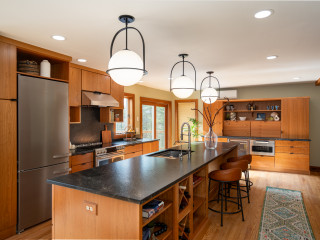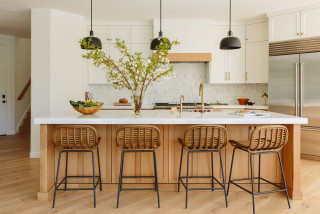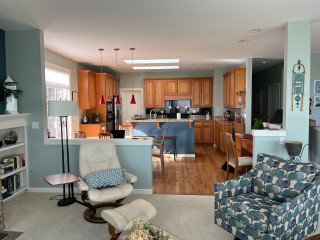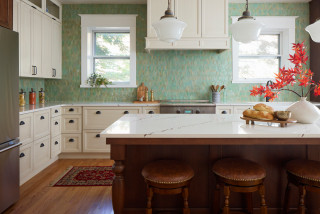
This article was originally published by a www.houzz.com . Read the Original article here. .

This article was originally published by a www.houzz.com . Read the Original article here. .

The inspiration came from one of Klosterman’s recent projects the couple admired. “I suggested a clean, traditional style with a lighter palette of creams, ivories, taupes and off-black accents,” she says. In the kitchen, the designer replaced the hodgepodge of styles and novelty appliances with streamlined, well-proportioned elements and a refined material palette. The result is a functional, elegant space with a clean-lined look.
This article was originally published by a www.houzz.com . Read the Original article here. .

Llogarajah, using Houzz Pro, addressed the look of the space and tweaked the layout to create a more family-friendly environment. And thanks to some thoughtful and sustainably minded choices, it was all done on a tight budget. Check out the before-and-after photos below.
This article was originally published by a www.houzz.com . Read the Original article here. .

If you like entertaining or eating everyday meals at a breakfast bar, then an island with more overhanging area and less cabinetry or storage underneath might be for you.
Think about how you imagine using the bar both every day and on special occasions. We’re realistic with many clients who have families in pointing out that children will often sit there and talk with parents, complete homework, use devices and eat (sometimes all at the same time) — I call this the “mission control” island breakfast bar.
Think about whether the sitting area needs to be closer to the fridge and pantry. This is another way of managing who is walking in and out of the kitchen, and who can be kept on the outside edges of the island — for safety as well as to avoid overcrowding in the kitchen.
Some people like to drop down part of the island to table height (around 29 inches) rather than the standard 36-inch-high countertop. This can work really well in some kitchens, but do be careful that you don’t inadvertently limit your storage and appliance options by having a really large table section on the island.
This article was originally published by a www.houzz.com . Read the Original article here. .

This retired couple in Washington state were ready to trade the cramped, dated kitchen in their 1990s split-level home for something brighter, smarter and more functional. Basic maple cabinets fell short on storage, and a bulky two-tier island made walkways uncomfortably tight. While skylights and a nearby sliding door offered some natural light, the lack of a window left the space feeling dark.
Designer Molly Erin McCabe guided the couple beyond their initial idea of a light refresh to a full remodel that reconfigured appliances, opened up circulation and brought in a garden view. Warm cherry cabinetry now stretches to the ceiling, maximizing storage and beautifully complementing a soft blue backsplash. A sleek single-level island creates better flow, while a new bar area with a beverage fridge improves entertaining.
Before Photo
Kitchen at a Glance
Who lives here: A recently retired couple
Location: Kingston, Washington
Size: 280 square feet (26 square meters), including a breakfast area
Designer: Molly Erin McCabe of McCabe by Design
Before: This view from the living room shows the former kitchen in the background. While the size of the open layout was adequate, short basic maple cabinets without knobs or pulls offered little storage or style. Granite tile counters and a black tile backsplash paired with a mix of black and stainless steel appliances felt dated. The bulky two-tier island cramped circulation. “It was probably the first thing out of my mouth,” McCabe says. “They didn’t have sufficient aisleways.” A breakfast area with a wood table and chairs and a sliding glass door to a deck connected the kitchen and living room.
Frameless cherry cabinets with a warm brown stain extend to the ceiling, maximizing storage. “It was configured for how the clients live and how they cook,” McCabe says. “My objective was to create storage that was inside the kitchen, to minimize trips into the pantry. The cherry also has a richer tone.”
The cabinetry pairs with the existing red oak floor, which was patched with new boards where the island was moved and then refinished with a matte urethane coat. “Because we moved the island, we had to weave in new boards,” McCabe says. “We kept the project cost down by only having to refinish the floor in the kitchen.”
Cabinetry: Bria cabinet line in door style Carson in cherry with Toast stain, Dura Supreme Cabinetry; wall paint: Comfort Gray, Sherwin-Williams
Find kitchen remodelers near you
Before Photo
Before: The blue-and-wood two-tier island with overhang and stools crowded the adjoining breakfast area. The black tile backsplash paired with a black propane cooktop and inefficient downdraft vent made that side of the kitchen feel especially dark. The two fixed skylights were incorporated into the new design.
A 30-inch built-in induction cooktop in black glass replaces the former propane unit in roughly the same location. It’s paired with a wall-mounted stainless steel hood that improves air quality and helps keep surfaces clean.
For the backsplash, McCabe used handcrafted glazed ceramic blue picket tiles with tonal variation and light gray grout. “The blue tile in the backsplash ties in the blue hue that flows through the home, and the scale of the tile adds interest without creating visual clutter,” she says. A paneled door on the left leads to an existing walk-in pantry.
Backsplash tile: Watercolors picket in Whitney, Lunada Bay Tile; counters: Swanbridge, Cambria; hardware: Amwell in Ash Gray, Top Knobs
Before and After: 4 Appealing Kitchens in 300 Square Feet
Before Photo
Before: This view shows the interior side of the former island, which held a white double-bowl sink, sink cabinet and dishwasher. “There was no space to the right of the sink, which created a hazard,” McCabe says.
A black wall oven and a small black microwave sat next to the refrigerator alongside a short run of cabinetry and counter that ended just before the sliding glass door. “There was about 11 inches or so between the casing of the door and the cabinetry,” McCabe says.
The new undermount workstation sink in brushed stainless steel features a motion-activated smart pull-down faucet with a spot-resistant finish. “The plumbing from the island was rerouted through the floor joists to that wall,” McCabe says. “There’s a whole floor of the home below. Running the plumbing through the floor joists was instrumental to keep the costs down. The workstation sink effectively creates more counter space and makes food prep a breeze with multiple accessories.”
The couple’s existing top-control stainless steel dishwasher was reinstalled to the right of the sink. A valance above integrates LED pods for task lighting, and the updated plan also includes new ceiling LEDs and glass bulb pendant lights over the breakfast table.
See why you should hire a professional who uses Houzz Pro software
Before Photo
Before: Across from where the refrigerator and wall ovens were, a short run of cabinetry and counter went largely unused. “The cabinets there were only 21 inches deep instead of 24,” McCabe says. Nearby, a desk area by the dining table often became a dumping ground. “They wanted a beverage center,” McCabe says.
The former desk area became a bar, featuring an undercounter beverage refrigerator and cabinets for storing spirits and entertaining supplies. “The beverage fridge and countertop help keep guests close by when entertaining, without making them feel like they are in the way,” McCabe says.
New to home remodeling? Learn the basics
Before Photo
Before: The former kitchen felt smaller than its actual size due to the shape and placement of the two-tier island (center), which made walkways tight, especially between the island and dining table (bottom right).
The refrigerator and wall ovens (bottom left) were positioned along the exterior wall, while the desk (top right) and a short run of cabinetry and counter (top left) sat across the room. The cooktop was on the left, opposite the island sink.
More on Houzz
Read more kitchen stories
Browse kitchen photos
Hire a kitchen remodeler
This article was originally published by a www.houzz.com . Read the Original article here. .

The biggest cost in a kitchen remodel is new cabinets. The most expensive option is custom, in which cabinetry is designed, built and installed to specifically fit your space. Exotic woods, ornate details and period styles add to the cost and delivery time but result in a one-of-a-kind kitchen.
If your budget doesn’t allow for custom, but you need new cabinets, ready-to-assemble cabinetry is a good option. Ready-to-assemble or semicustom cabinets can sometimes be half the cost of custom, depending on the material, style and cost of installation. Semicustom cabinets are selected from existing designs and are prefabricated offsite in standard sizes, with limited size, style, material and finish options.
In-stock cabinets are for customers who want to grab their cabinets right off the shelf and get going. These stock cabinets come in standard sizes, shapes and colors. Since the cabinet dimensions are not based on your kitchen,fillers may be required to make the cabinets fit. These cabinets are very affordable for remodelers on a budget.
Find a general contractor on Houzz
This article was originally published by a www.houzz.com . Read the Original article here. .

After living in their Michigan home for about 20 years, these retirees were ready to tackle their dated, cramped kitchen, which was cut off from the dining room by a partition wall. They loved the warmth of the vaulted, stained wood ceiling but wanted a more open, functional space. They turned to designer Oliver McCarthy, who uses Houzz Pro software, for help.
McCarthy removed the partition and expanded the kitchen into the dining room, adding 180 square feet. The new layout accommodates a larger island with seating and storage. Two-tone cabinets in light mocha and earthy gray-brown add depth and maximize storage, while a few glass-front units and a wide gliding window over the farmhouse sink keep the space feeling light. Handy pullouts, a welcoming beverage nook, durable sand-colored porcelain tile flooring and sleek black appliances give the kitchen a sophisticated finish.
Before Photo
Kitchen of the Week
Who lives here: A retired couple
Location: Ada, Michigan
Size: 330 square feet (31 square meters)
Designer: Oliver McCarthy of Delight In Designs
Before: The 150-square-foot kitchen, with its dark taupe walls, beige tile flooring and a vaulted stained wood ceiling, felt cramped. A long, narrow island had tight seating on two sides, and short honey oak cabinets offered limited storage. A bulky stainless steel refrigerator jutted past the cabinetry, making the footprint feel even smaller. “The kitchen felt disproportionate to the size and overall layout of the house,” McCarthy says.
The refrigerator and range sat on the wall separating the kitchen from the dining room, with a pass-through awkwardly placed above the range. “That didn’t seem very safe,” McCarthy says. A sink and short run of cabinets lined the adjacent back wall, while the wall on the right held shallow pantry closets. The doorway in the back right corner connects to the garage.
Before Photo
Find kitchen remodelers near you
Taking down the partition and eliminating the formal dining room increased the size of the kitchen from 150 to 330 square feet. McCarthy says the couple used a previous addition to create a smaller dining and family area. Because most meals are now enjoyed at the new island, losing the formal dining room wasn’t a concern.
The expanded footprint allowed for a spacious island with seating and storage. Perimeter cabinets in light mocha contrast with the island’s earthy brown-gray finish. “When there’s an opportunity to do a two-tone look in this kind of large-sized space, it gives you the chance to do a more statement color for the island and go with a more neutral, timeless color on the perimeter,” McCarthy says.
A bronze-finish linear chandelier over the island coordinates with the island base and oil-rubbed bronze hardware. Tan performance leather swivel stools provide comfortable seating. A black stainless steel French door refrigerator now sits on the sink wall. “With that being the entry point from the garage, it’s a good place for them to unload groceries,” McCarthy says.
He used Houzz Pro to manage the project and create estimates.
Cabinetry: Concord 275 door style in Light Mocha (perimeter) and Urbane Bronze (island), Showplace Cabinetry; cabinetry hardware: Revitalize in oil-rubbed bronze, Amerock Hardware; stools: Russell, Amisco
See why you should hire a professional who uses Houzz Pro software
Walls painted a muted warm white (Sanctuary by Sherwin-Williams) with creamy white trim (White Sand by Sherwin-Williams) create a light, cozy backdrop. “The creamy white we used here doesn’t have those yellow undertones that some people don’t like,” McCarthy says.
Flooring: Regency in Sand, 12 by 24 inches, Virginia Tile Co.
Shop for your kitchen
Illuminated glass-front upper cabinets lighten the range wall and showcase finer glassware and dishes. “Since they have a ton more storage than before, we felt it was a good opportunity to have that open display,” McCarthy says.
Custom hood: Sinda Copper Co.
10 Stylish Kitchen Islands That Invite Conversation
Pullouts on either side of the range keep essentials within reach, from canned goods to cooking tools. The pullout to the left contains a knife block and holders for utensils like ladles and spatulas, while the pullout in the foreground of this photo stores baking sheets and pans.
Above the range, a focal-point design of matte ceramic tiles with an aged bronze finish adds texture and depth. “I felt it was a nice accent to break up the space and an opportunity to add a fun or unique element,” McCarthy says.
Tile above range: Jonathan Adler Shelter Island in Aged Bronze, Lunada Bay Tile
25 Genius Kitchen Storage Ideas
The 8-foot-wide custom gliding window frames backyard views. Its single sash slides horizontally for full ventilation, and the quartz sill matches the counters. “They didn’t want to go with something like a casement window that tends to get dirty during rainy weather,” McCarthy says.
Sconces: Brock in oiled bronze, Capital Lighting; sink: Turino, Kraus; faucet: Bellera in oil-rubbed bronze, Kohler; window: E-Series Gliding Window, Andersen Windows + Doors
Before and After: 4 Inviting Kitchens in 120 to 160 Square Feet
How to Design a Multigenerational Kitchen
Microwave drawer: Sharp
New to home remodeling? Learn the basics
More on Houzz
Read more kitchen stories
Browse kitchen photos
Hire a kitchen remodeler
Shop for kitchen products
This article was originally published by a www.houzz.com . Read the Original article here. .

This empty-nest couple in California turned to designer Lori Ramsay to help reimagine the basic white kitchen in the wife’s Mediterranean-style childhood home, located in a San Diego master-planned community. Their goal was to honor cherished memories while improving function, storage and style in the 125-square-foot space. Ramsay kept the original footprint mostly intact but elevated the design with white-and-wood cabinetry, brass hardware, and countertops and a backsplash in striking white granite with bold veining and forest green crystals. A new peninsula adds storage, seating and a workstation sink, while the former breakfast area now houses a glamorous bar with glass-and-brass shelving.
Before Photo
Kitchen at a Glance
Who lives here: An empty-nest couple
Location: San Diego
Size: 125 square feet (11.6 square meters)
Designer: Lori Ramsay Design
Before: The nearly all-white kitchen included a short peninsula, white appliances, white solid-surface counters and basic cabinetry without hardware. A cove ceiling added to the dated look. “The cove ceiling was something I wanted to remove, but the budget wouldn’t allow it,” Ramsay says.
While the layout created an efficient work triangle between the sink, range and refrigerator, a small microwave above the range lacked proper ventilation, and the bulky refrigerator jutted into the walkway. “The kitchen functioned very well,” Ramsay says. “The primary concern was that the whole thing was dated and didn’t have style. This homeowner has great taste and the dated kitchen didn’t reflect her personality.” The wood-look laminate floor offered a visual break from all the white but was worn and ready for replacement.
A soft white wall and ceiling color with warm khaki undertones (Neutral Ground by Sherwin-Williams) creates a cozy backdrop that helps the cabinetry stand out. Polished Alpine granite, with bold ebony, graphite and gray veining and forest green crystals, forms the countertops and slab backsplash, adding color, movement and drama. “That was the kickoff for the kitchen,” Ramsay says. “She found that slab and fell in love with it, and that informed all the other decisions.”
Cabinetry hardware: Erika pull in warm brass, Atlas Homewares
Find kitchen remodelers near you
In addition to the lights inside the hood, the kitchen also includes updated LED ceiling lights and undercabinet lights over task areas.
Range: Café; range hood insert: Monsoon Mini II, Zephyr
Shop for your kitchen
Before Photo
A pantry cabinet next to the refrigerator had fixed shelves inside. “It was only 12 inches deep,” Ramsay says. “That’s why you see such a disparity between the full-depth refrigerator and the pantry.”
See why you should hire a professional who uses Houzz Pro software
Before and After: 4 Inviting Kitchens in 120 to 160 Square Feet
25 Genius Kitchen Storage Ideas
To the left of the sink is a double-drawer white-and-gold dishwasher that complements the fridge. A trash and recycling pullout sits in the peninsula, perpendicular to the sink. “We couldn’t fit the trash to the right of the sink, so that was the most logical place to put it,” Ramsay says. “Because these homeowners are empty nesters, using one small oven or one of the dishwasher drawers just makes sense.” Floating rift-cut white oak shelves at the end of the upper cabinetry provide a perfect spot for plants or decorative items.
Sink: Elkay; faucet: Artesso in luxe gold, Brizo
6 Expert Tips for Banishing Kitchen Clutter
Before Photo
Before: A small breakfast area with a table and chairs sat just off the kitchen but wasn’t used regularly. “They didn’t use it often and she wanted a bar,” Ramsay says. A pot rack hung over the sink, adding visual clutter. A structural post in the space needed to remain in place, as removing it would have been too costly.
New to home remodeling? Learn the basics
Custom brass shelving: Soil & Oak Design; glass shelving: RB Glass & Mirror
This article was originally published by a www.houzz.com . Read the Original article here. .

“The client really liked that this tile looked lived-in from the start, because they didn’t want to be concerned about it not looking pristine all of the time,” she says. They also chose unlacquered brass for the perimeter cabinet hardware and lighting “to lean into that patinaed look,” she says.
The previous layout of the major appliances worked well, so Flake was able to save on costs by keeping them in the same locations. Above the new JennAir gas range is a custom hood wrapped in red oak with a gray granite trim, both of which match the new island, which is in the foreground of the photo. The perimeter cabinetry now stretches to meet the 10-foot ceiling, emphasizing its height and updating its look.
Paint colors: Green Earth (perimeter cabinets), Alabaster (walls), Accessible Beige (trim), Sherwin-Williams
Perimeter countertops: Calacatta Lavasa quartz, MSI; island countertop: Silver Gray leathered granite
This article was originally published by a www.houzz.com . Read the Original article here. .

“They absolutely loved their kitchen in Texas,” interior designer Theresa Dorlini says. “They had completed a lot of updates on that kitchen, and they shared photos of it with us. While this kitchen looks nothing like that kitchen, we were able to pick up on a lot of what they loved about it and give it to them here.”
The new kitchen may look different, but it feels right at home in their 1915 house. Architectural details, cabinetry with a furniture-like feel and vintage-style opaque glass pendant lights give the space a timeless character that suits the age of the home. At the same time, modern conveniences — like updated appliances, a coffee bar and well-equipped cabinets — add comfort and functionality.
This article was originally published by a www.houzz.com . Read the Original article here. .
Kitchen at a Glance
Who lives here: A couple
Location: Duanesburg, New York
Size: 275 square feet (26 square meters)
Design-build pro: Marianne A. Clifford of Marianne Ashley Designs
Clifford removed the old appliances, cabinets, counters and floor, along with the two-level island, making way for a more than 12-foot-wide, one-level island with seating and storage. “It offers a lot more options on how the island can be used,” she says. The new layout improves sightlines and makes the kitchen feel open and inviting.
The island base and perimeter cabinets are semicustom cherry flat-panels with a natural finish and matte black ledge pulls. “A lot of the woodwork in their home was already cherry, so we wanted to create a unified look,” Clifford says.
The upgraded stainless steel refrigerator stayed in place, while an added open upper cabinet and tall pantry on the side expand storage. “There are hooks inside that pantry cabinet for hanging a step stool and broom,” Clifford says.
Modern counter stools with cognac leather upholstery and curved low backs sit at the island, while contemporary pendant lights with etched opal glass shades and matte black frames hang overhead. The ceiling has new LED recessed lights on dimmers. “This gives them full control,” Clifford says.
Pendant lights: Somerset, Hinkley Lighting; stools: Zion, Ballard Designs
Find kitchen remodelers near you